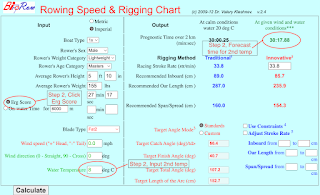Reference 6K (in late January) and water temp
Hey Magda and Dale, this is a goofy follow-up to your brief conversation I overheard where Dale feigns mock concern that we'll never be able to match our reference 6K due to such favorable rowing conditions.
Well, I got to thinking about it and, while I agree last Friday (1/26) had exceptional conditions, it probably did not represent the fastest conditions we'll encounter on the 6k sushi course. In particular I was thinking about water temp, the cold temp of last Friday versus the warmer temps we see at the beginning of sushi. Plus there are other considerations like eastbound head-currents from rain runoff and actually-not-that-great wind. All contribute to slower than the fastest conditions.
In this note I consider water temp differential. Today's Lake Washington water temp is reported as 8.3° C.
Believe it or not, the water temp was around a degree colder last Friday, but to err on the conservative side let's call it 8°. You can find historical as well as current temps at King County's Lake Buoy data page.
Water temps are around 20° C or a bit warmer when we start Sushi in September. So to rephrase the question, "how meaningful is an 8° to 20° temperature differential in a 6K"?
Skin drag is the largest force to overcome in a rowing shell. Skin drag is estimated to be around 80% of total drag. Skin drag depends on the Reynolds number, which in turn depends on, among other things, fluid density and fluid viscosity, both of which have a temperature dependence. See this note from C. Douglas and this article from Kleshnev. There's a lot going on here; it's complicated.
However, Kleshnev makes it easy to calculate the impact of water temp on a race piece with his rigging calculator, which incorporates all of the above and a whole bunch more. Let's give it a try (see steps 1 and 2 below).
So, assuming equivalent rowers in Sept and January, the 12° difference leads to a 18 second SLOWER Kleshnev forecasted time. Significantly slower from this one factor alone.
Note, I used my stats, specifically my body weight; Dale, your body weight will make a much bigger difference.
I would guess that rain runoff head-current could easily generate a similar effect. As could the absence of a south tailwind.
In case you're curious about the blogger.com email, I'm experimenting with using email to automatically generate blog posts. If you also curious how well this works, checkout https://hankinator.blogspot.com/.
Cheers,
Hank
Step 1. Input stats into rigging calculator, click calculate, and get corresponding erg time, 27:17.
Step 2. Use Erg Score, enter new water temp, observe new forecast OTW time, 30:17.88.





Comments
Post a Comment